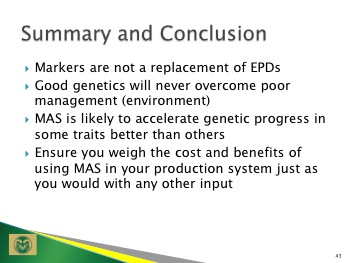Genomics for the Rancher
by Troy Smith for Angus Productions Inc.
MITCHELL, Neb. (Nov. 30, 2011) — On Day 2 of Range Beef Cow Symposium XXII, Colorado State University Extension beef specialist Jack Whittier offered a rancher’s “primer” on genomics — the study of genes and their function — and explained how application of the science is providing modern tools for genetic improvement through seedstock selection.

Jack Whittier
Whittier discussed the terminology of genomics and explained how samples of an animal’s DNA are tested or evaluated for SNPs (single nucleotide polymorphisms) known to be associated with genes influencing the expression of particular production traits.
According to Whittier, two primary companies have technology to test for genetic defects, parentage, coat color, horned/polled and genetic merit for performance traits such as carcass tenderness, marbling, yield grade, ribeye area and others.
Whittier reminded the audience that expected progeny difference (EPD) values, used for at least 25 years to evaluate an individual’s genetic merit, are based on the actual performance of individual sires and their progeny. The progeny testing important to collecting data for calculation of EPDs is both time-consuming and expensive, costing up to $25,000 per bull. Whittier said genomic data, derived from sampling DNA and evaluating it for gene markers, is now being integrated with traditional EPDs, resulting in marker-assisted EPDs or molecular breeding values (MBVs).
Whittier likened the application of these predictors of genetic merit to the application of more rigorous analysis of nontraditional player statistics in Major League Baseball, as depicted in the film, Moneyball.
 “With the development of genomics, predictors like molecular breeding values for economically relevant traits may allow cattle producers a better way to identify valuable animals, using ‘player statistics’ coupled with DNA markers,” said Whittier. “New tools, such as genomics provide a new method to gain enhanced genetic information without the time and expense required to test a large number of progeny.”
“With the development of genomics, predictors like molecular breeding values for economically relevant traits may allow cattle producers a better way to identify valuable animals, using ‘player statistics’ coupled with DNA markers,” said Whittier. “New tools, such as genomics provide a new method to gain enhanced genetic information without the time and expense required to test a large number of progeny.”
To see Whittier's PowerPoint presentation, click here.
The biennial Range Beef Cow Symposium was hosted Nov. 29-Dec. 1 at the Mitchell Events Center, Mitchell, Neb., by the cooperative extension and animal science departments of the University of Nebraska-Lincoln, South Dakota State University, Colorado State University and the University of Wyoming. Comprehensive coverage of the event is provided online at www.rangebeefcow.com, an event coverage site provided by Angus Productions Inc. (API), publisher of the Angus Journal and the Angus Beef Bulletin.
Editor’s Note: API's coverage of the event is made available for distribution to all media via an agreement with the Range Beef Cow Symposium Committee and API. Headquartered in Saint Joseph, Mo., API publishes the Angus Journal, the Angus Beef Bulletin, the Angus Beef Bulletin EXTRA, and the Angus e-List, as well as providing online coverage of events and topics pertinent to cattlemen through the API Virtual Library. For questions about this site, or to notifiy us of broken links, click here.

